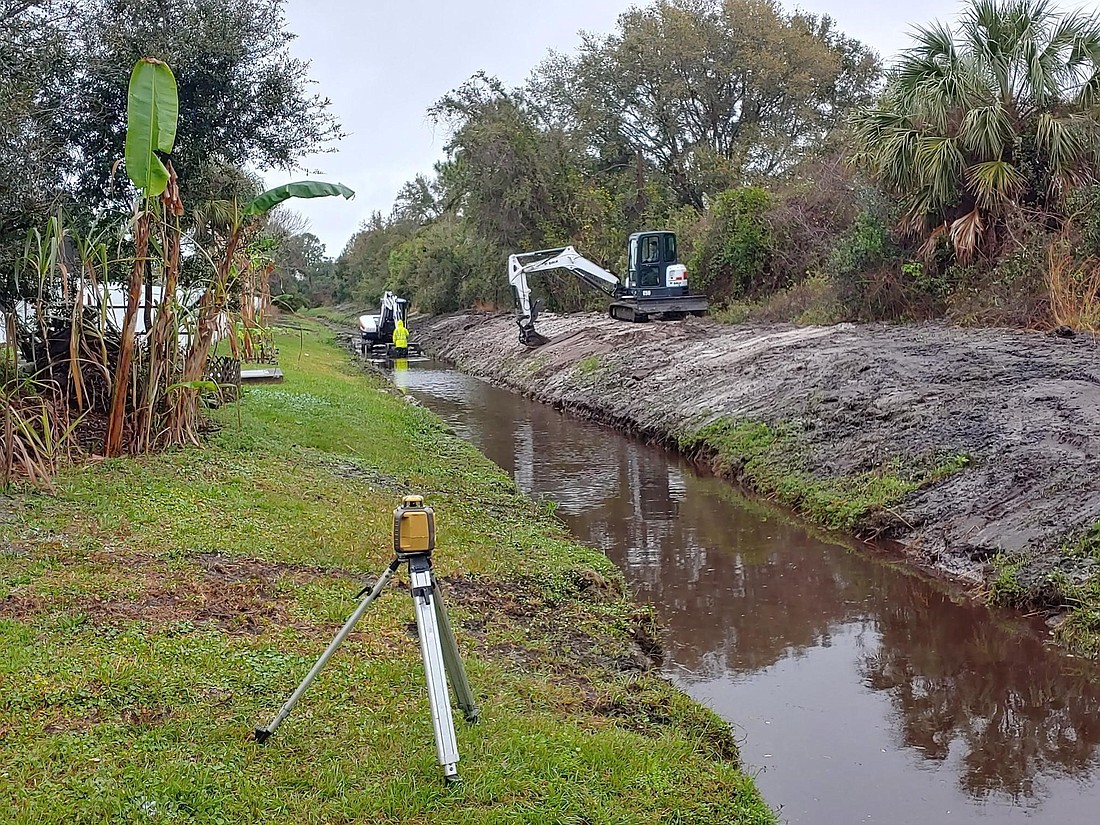- December 15, 2025

What happens to a drop of rainwater after it falls on your lawn, makes its way to your swale, then flows toward a ditch?
One city of Palm Coast division makes sure stormwater gets where it’s supposed to go, rather than flooding streets, yards and homes.
The city’s Stormwater Division staff uses geospatial technology — the kind used by FEMA — to track where water will go as it flows off local yards, streets and parking lots.
"Our primary function is to reduce flooding and protect people and property."
— MIKE PEEL, Palm Coast stormwater engineer
Since 2019, according to a city staff presentation at a Jan. 11 City Council workshop, the Stormwater Division has created a Citywide Stormwater Modeling and Master Plan, a Ditch Rehabilitation and Maintenance Program and an Infrastructure Inspection Program that’s completed 85 inspections over the past two years.
Some of the division’s work is helped by the way Palm Coast was created.
“It’s unique, in the sense that it is a very young city, essentially built by a major development corporation,” city Stormwater Engineer Mike Peel said. “Some of the work that ITT did, we’ve been able to pick up and take advantage of.”
The division uses modeling to simulate where water would flow and collect in different kinds of storm events — a 2-year storm, a 10-year storm, a 100-year storm — and which changes would provide the greatest benefit to the largest number of people.
“I find it useful that there was some stormwater planning earlier because Palm Coast was a planned community,” stormwater engineer Carmelo Morales said. “So from a design perspective, I don’t have to redo the work. I already have a large amount of that data, so it’s more recompiling than engineering today’s stormwater needs.”
SWALES
When Palm Coast residents think stormwater, many think of swales — a stormwater feature common in Palm Coast, but less so elsewhere.
Perhaps the most noticeable feature of the city’s stormwater management system, these pseudo-ditches keep water from backing up toward homes and filter it before it percolates down toward the water table.
“Swales are intended to do that during that first flush of water or rain,” Morales said. “You want that to slow down. The grass or vegetation has time to kind of remove those contaminants.”
The city’s more than 1,200 miles of swales are a Sisyphean project for stormwater staff, continually requiring maintenance.
The city has a goal to regrade and rehabilitate 25 miles worth of them each year, and this year, with new equipment and a staff reorganization, was able to do 37 miles.
This most visible of stormwater features is potentially also the most misunderstood, Peel said. When water sits in swales for a while, it can alarm or annoy residents.
“We fully understand — if I’m a homeowner, I’m concerned about the fact that water’s standing in there too much,” Peel said. But, he added, “I think most citizens probably have a misconception as to the impact that has on the system.”
Even if a swale is flooded, it’s not going to flood your house, he said. Ditches are a different matter, he said: Keeping those flowing is important.
Palm Coast has two maintenance crews dedicated to swales, two dedicated to ditches, and one dedicated to pipe maintenance.
PROJECTS
Some of the water that flows from a yard to a swale to a ditch ends up in a freshwater or saltwater canal.
But some of it makes its way to low-lying wetland areas like Graham Swamp.
“They serve a vital function: They help slow the water down, they help filter out a lot of pollutants and they help provide habitat for wildlife,” Peel said. “Graham Swamp connects to the Intracoastal, and of course, that’s a large conservation area and it’s got a lot of low-lying areas, so it does at times serve as a kind of holding area.”
When water heads to an outfall that’s a protected area with a conservation easement, that can make stormwater staff’s work harder — it means they can’t do much to alter the land to improve flow. When water is high in Graham Swamp, it affects the stormwater upstream.
The city’s stormwater staff views the city’s streets and communities as a series of basins and sub-basins, each requiring attention.
A number of projects are underway or in the planning phase. Among them is a set of improvements designed to improve water flow in the Woodlands area near Colbert Lane and Blare Drive, north of the swamp.
“It increases the capacity at which water can flow through there, through that culvert,” Morales said. “That has an immediate positive impact to the Woodland area.”
Once it’s done, water will drain much faster after heavy rains, he said.
Other projects will include drainage improvements in the K-Section, dredging of E-Section freshwater canals and the replacement of the city’s largest weir, on the Royal Palms Canal.
“We found some opportunities to create some additional capacity,” Peel said. “A lot of this stuff allows the system to recover a lot faster.”